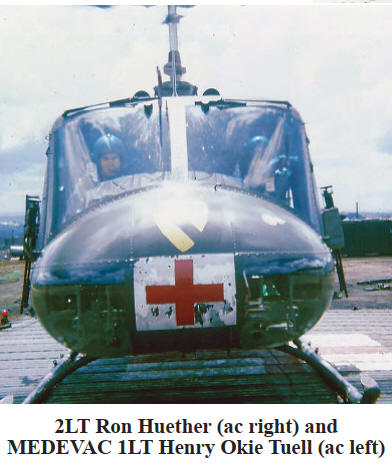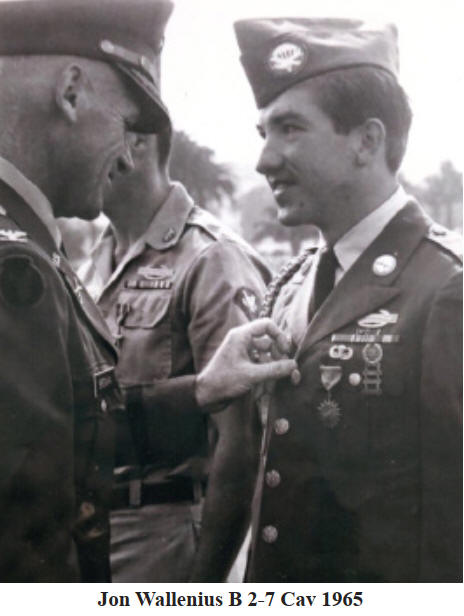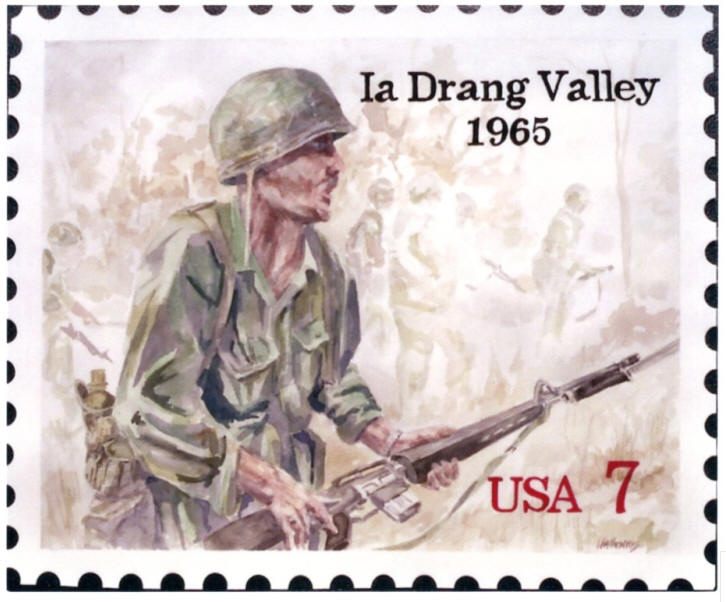Saber Article Index
Jan-Feb Saber
Mike Bodnar
307B N Main Copperas Cove, TX 76522
254-542-1961
E-mail:
mbodnar27@gmail.com
 A correction to the last column is 1st
Cav Assn Programs Director Tina Wilgeroth informed me from her
database check that Ron Huether is a member of the 1st Cavalry
Division Association, since 2018. Like all other members of the 1st
Cav Div Assn, he has the choice to be as active as he wants to be.
A correction to the last column is 1st
Cav Assn Programs Director Tina Wilgeroth informed me from her
database check that Ron Huether is a member of the 1st Cavalry
Division Association, since 2018. Like all other members of the 1st
Cav Div Assn, he has the choice to be as active as he wants to be.
I received snail mail from 196511C B Co,
2-7 Cav Jon Wallenius, in response to my Sept/Oct
Saber column. Jon said he read with interest, and a
lot of empathy, my writing about the awarding of the Combat Medical
Badge. He said that he has similar experiences with the Combat
Infantryman Badge, which he properly earned.
Jon was in heavy mortars in the 2nd
Infantry Division which became the 1st Cavalry Division after war
games with the 11th Air Assault Division (Test). His unit became B
Co 2-7 Cavalry and was attached to 1-7 Cavalry which was under
strength at LZ X-Ray in the Ia Drang.
Jon mentioned certain non-infantry CIB
holders, one whom I know, who are not qualified, he says, stealing
valor from those who are. The Army regulation implies, but I do not
see it specifically stated, that the Soldier must have an 11 MOS.
Unless that has changed, an infantry Soldier is still an 11 MOS
series. Anyone who does not have an 11 MOS, who says they have a
CIB, is not qualified; never has been, nor never will be qualified.
Another qualification is, a recipient must be personally present and
under hostile fire while serving in an assigned infantry or SF
primary duty, in a unit actively engaged in ground combat with the
enemy. I do see 11B MOS as infantryman in the CAB AR, mentioned
below, which attempts to distinguish between who is eligible for
which award.
I have met U.S. Army Veterans who had an
11 MOS but were not functioning with the other requirement. That is,
assigned infantry duty in a unit actively engaged in ground combat
with the enemy.
The AR states: “
(3) The definition of requirement to be
‘engaged in active ground combat’ has generated much dialogue over
the years as to the original intent of the CIB. The intent has been
clarified over time as being personally present, under fire, and
engaging inaction against the enemy in ground forces combat. It is
not awarded for battle participation credit.
b. For award of the CIB a Soldier must
meet the following three requirements:
(1) Be an infantry Soldier satisfactorily
performing infantry duties.
(a) A Soldier must be an Army infantry or
SF officer (CMF or AOC 11 or 18) in the grade of COL/O6 or below, or
an Army enlisted Soldier or warrant officer with an infantry or SF
MOS who, subsequent to 6 December 1941, has satisfactorily performed
duty while assigned or attached as a member of an infantry, ranger,
or SF unit of either a brigade, regimental, or smaller size during
any period such unit was engaged in active ground combat.
(b) Eligibility for SF personnel in MOSs
18B, 18C, 18E, 18F, and 18Z (less18D – SF medical sergeant) accrues
from 20 December 1989. Retroactive awards of the CIB to SF personnel
are not authorized prior to 20 December 1989.
(2) Be assigned to an infantry unit
during such time as the unit is engaged inactive ground combat.
 106 AR 600–8–22 • 5 March 2019
106 AR 600–8–22 • 5 March 2019
(a) A recipient must be personally
present and under hostile fire while serving in an assigned infantry
or SF primary duty, in a unit actively engaged in ground combat with
the enemy. The unit in question must be a brigade, regiment, or
smaller size. For example, personnel possessing an infantry MOS in a
rifle squad of a cavalry platoon in a cavalry Troop would be
eligible for award of the CIB. Battle or CPC alone is not
sufficient; the unit must have been in active ground combat with the
enemy during the period.
(b) Personnel with other than an infantry
or SF MOS are not eligible, regardless of the circumstances. The
infantry or SF CMF, AOC or MOS does not necessarily have to be the
Soldier’s primary specialty, if the Soldier has been properly
trained in infantry or SF tactics, possesses the appropriate skill
code, and is serving in that specialty when engaged in active ground
combat as described above. Commanders are not authorized to make any
exceptions to this policy.
(c) Awards will not be made to general
officers or to members of headquarters companies of units larger in
size than brigade.
(3) Actively participate in such ground
combat. Campaign or battle credit is not sufficient for award of the
CIB.
c. The CIB is authorized for an award for
the following qualifying wars, conflicts, and operations. Second and
third awards of the CIB are indicated by superimposing one and two
stars respectively, centered at the top of the badge between the
points of the oak wreath. To date, a separate award of the CIB has
been authorized for qualified Soldiers in the following qualifying
periods:” TheAR goes on to list those periods:
<https://armypubs.army.mil/epubs/DR_pubs/DR_a/pdf/web/ARN18147_R600_8_22_admin2_FINAL.pdf>
pages 106-108, including special provisions. The CIB AR starts out
by saying: “8 – 6. Combat Infantryman Badge.
a. The CIB was established by the War
Department on 27 October 1943. The CIB was designed to enhance
morale and the prestige of the ‘Queen of Battle. ‘The badge was
intended as an inducement for individuals to join the infantry while
serving as a morale booster for infantrymen serving in every
theater.
(1) Several factors led to the creation
of the CIB, an award that would provide special recognition of the
unique role of the Army infantryman, the only Soldier whose daily
mission is to close with and destroy the enemy and to seize and hold
terrain. “
It should be understood: “
(2) In developing the CIB, the
War Department did not dismiss out of hand or ignore the
contributions of other branches. Their vital contributions
to the overall war effort were certainly noted, but it was
decided that other awards and decorations to retain the
badge for the unique purpose for which it was established
and to prevent the adoption of any other badge, which would
lower its prestige. At the close of World War II, the
largest war in which the armor and artillery played key
roles in the ground campaigns, a review was conducted of the
CIB criteria with consideration being given to creating
either additional badges or authorizing the badge to cavalry
and armor units. The review noted that any change in policy
would detract from the prestige of the badge.”
Only the Combat Medical Badge was allowed
to provide recognition to the field medic who accompanies the
infantryman into battle and shares experiences unique to the
infantry in combat.
Then, on 2 May 2005, the chief of staff
of the Army (CSA) approved the creation of the Combat Action Badge
(CAB) to provide special recognition to Soldiers who personally
engaged, or are engaged by, the enemy. The CAB is intended to serve
as a companion to the CIB and CMB to recognize the greatly expanded
role of non-infantry Soldiers in active, ground combat. The CAB has
its own AR requirements which I will not write about. They are
complicated and can be read about in the AR mentioned above, pages
110-112. Retroactive awards of the CAB are not authorized prior to
18 September 2001.
 I know of-and there were many,
many-artillery forward observers who were assigned to infantry units
who went through the same experiences as their infantry units but
were not qualified for the CIB. Now, the CAB should be a respite.
Before, they only had pride in knowing that their skills contributed
to so much in their units. Also, as the AR states, other awards and
decorations were sufficient to recognize their contributions.
I know of-and there were many,
many-artillery forward observers who were assigned to infantry units
who went through the same experiences as their infantry units but
were not qualified for the CIB. Now, the CAB should be a respite.
Before, they only had pride in knowing that their skills contributed
to so much in their units. Also, as the AR states, other awards and
decorations were sufficient to recognize their contributions.
The only AR time factor of thirty days I
have read in regards to the awarding of combat badges is: during the
Vietnam Conflict, any officer whose basic branch is other than
infantry who, under appropriate orders, commanded a line infantry
(other than a headquarters) unit of brigade, regimental, or smaller
size for at least thirty consecutive days is deemed to have been
detailed in infantry and is eligible for award of the CIB
notwithstanding absence of a written directive detailing that
Soldier in the infantry, provided all other requirements for the
award have been met. There are other special situations mentioned
towards the end of section 8-6, but they all require situations that
engage the enemy and are under fire.
The attached stamp artwork is by Jon
Wallenius, who is an excellent artist. He mostly uses watercolors,
which I understand, the hardest to use.
FIRST TEAM!
Garryowen,
Mike
Bodnar C 2\7 '69
MEDEVAC 1-7\70
SO THAT OTHERS MAY LIVE